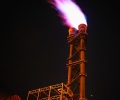Below-average weekly US natural gas storage build expected amid rising power burn demand

The U.S. Energy Information Administration (EIA) is expected to report a 70 Bcf injection to US gas storage for the week ended June 17, according to a survey of analysts by S&P Global Commodity Insights. Above-average gas-fired power demand has likely diverted some excess gas supply from the Freeport LNG outage away from storage toward power generators, leading to a below-average build.
Responses to the survey were reported in a wider range this week with expected injections ranging from 48 Bcf to 96 Bcf. The EIA plans to release its weekly storage report at 10:30 am ET on June 23.
A 70 Bcf weekly injection would dramatically exceed the 2021 corresponding-week injection of 49 Bcf but come in well below the five-year average injection of 82 Bcf. US storage levels would climb to 2.165 Tcf, expanding the deficit to the five-year average to 335 Bcf, while shrinking the gap to the corresponding week in 2021 to 309 Bcf.
NYMEX Henry Hub July fell to $6.829/MMBtu in June 21 trading, down around 14 cents from the prior-day settlement, data from CME Group showed. The prompt-month hadn’t settled below $6.90/MMBtu since late April. The July contract has fallen around 25% since a fire led to an extended outage at Freeport LNG in Texas on June 8.

Cooling demand
Record-setting heat across the eastern half of the country so far this June has lifted gas-fired power demand above the five-year average, a dynamic exacerbated by coal market factors that have made fuel-switching more difficult for generators.
Total US gas-fired power demand averaged 40.9 Bcf/d for the week ended June 17, nearly 7 Bcf/d higher than the previous week, and 3.9 Bcf/d above year-ago levels. Data from S&P Global showed that June 11-17 saw the strongest gas-fired power demand for that week on record, according to a dataset going back to 2012.
The unusually high temperatures can complicate supply and demand forecasting, which explains the wide range of survey results for the week ended June 17, according to Eric Brooks, a natural gas storage analyst with S&P Global.
“Climbing temperatures across the US can result in a mismatch between modeled demand estimates and actual fuel consumption, particularly during transition periods such as now,” Brooks said.
“Whatever the actual number will be, it is clear that the inventory change last week will be significantly less than normal,” Brooks said.
Outlook
Looking ahead, S&P Global’s supply-demand models forecasts a net injection of 59 Bcf for the week ending June 24 in a build that would undershoot the 73 Bcf observed in both the 2021 corresponding-week injection and the five-year-average injection.
Forecasts show very hot temperatures to continue across the Southeast and Texas for the week in progress, fueling gas-fired power demand for cooling. A second week of underwhelming injections could provide some support to natural gas futures prices.
Adding further pressure to storage levels, the US LNG feedgas demand picture may not be as bleak as the extended outage at Freeport initially suggested, as Venture Global’s Calcasieu Pass LNG quickly ramps up.
Pipeline nomination data shows that Calcasieu Pass feedgas demand reached a fresh record-high June 21, climbing to 1.54 Bcf. The June 21 highwater mark is just over 20% higher than the month-to-date average of 1.28 Bcf/d, and 54% higher than the May average of 1 Bcf/d.
Source: Platts

 Hellenic Shipping News Worldwide Hellenic Shipping News Worldwide, Online Daily Newspaper on Hellenic and International Shipping
Hellenic Shipping News Worldwide Hellenic Shipping News Worldwide, Online Daily Newspaper on Hellenic and International Shipping





















 PG-Software
PG-Software